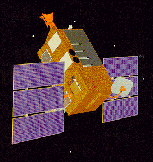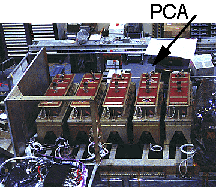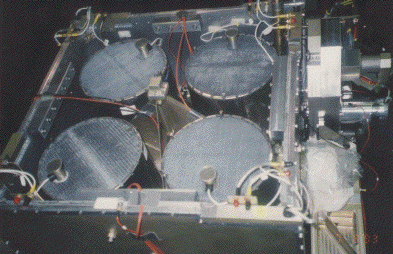Shedding a New Light on the Universe
The Rossi X-ray Timing Explorer
|
The Rossi X-ray Timing Explorer (RXTE), named after Bruno Rossi, discoverer of the first non-solar source of X-rays, was launched on December 30, 1995. Its instruments generate spectra and light curves, but not images. RXTE has three different scientific instruments on it, the Proportional Counter Array (PCA), the High Energy X-ray Timing Experiment (HEXTE), and the All-Sky Monitor (ASM). These three instruments complement each other for several reasons. For example, they all observe slightly different energy ranges.
|

|

|
The PCA has five xenon gas detectors (the X-rays will interact with the electrons in the xenon gas) that measure X-rays in the 2-60 keV range.
|
|
HEXTE has eight sodium-iodide crystal detectors that are gathered into two clusters, each containing 4 scintillation detectors that measure X-rays in the 10-200 keV range. While one cluster is pointed directly at the source, the other cluster is slightly offset, looking at blank sky. Each cluster is on a mechanism that "rocks" (by rotating on its axis) once every 32 seconds. So a given cluster will be pointing at the source for 32 seconds, then shifts to an off-source position and stays there for 32 seconds, then shifts back to the on-source position. (The other cluster is doing the opposite: off-source, on-source, off-source.) The data from one particular cluster are analyzed by subtracting the off-source position data from the on-source position data. The background subtraction helps reduce the "noise". |
 |
|
The ASM has three cameras that are mounted on a boom off the end of the spacecraft. Inside each camera is a proportional camera sensitive to energies in the 2-10 keV range. Each camera is able to look at a different region of the sky; two of the cameras have an overlapping field of view. The entire boom that the cameras are mounted on rotates by 6 degrees once every 90 seconds. Through this sequence of rotating and then staying fixed for 90 seconds, etc., the ASM covers 80% of the sky in 90 minutes.
|

|
It is good that parts of the ranges of these instruments overlap - it increases confidence in their scientific results! The ASM is a good instrument for monitoring the sky for transient, or short-lived events. The PCA and HEXTE complement the ASM by having the ability to follow up anything the ASM sees with more detailed and sensitive observations.
RXTE uses solar panels for power. The solar energy that they provide is the same as the solar energy we talk about using to make solar cars and solar house on Earth. For communication, RXTE uses two high gain antennas and several low gain ones. For guidance, it uses star trackers.

Previous |

Next |


